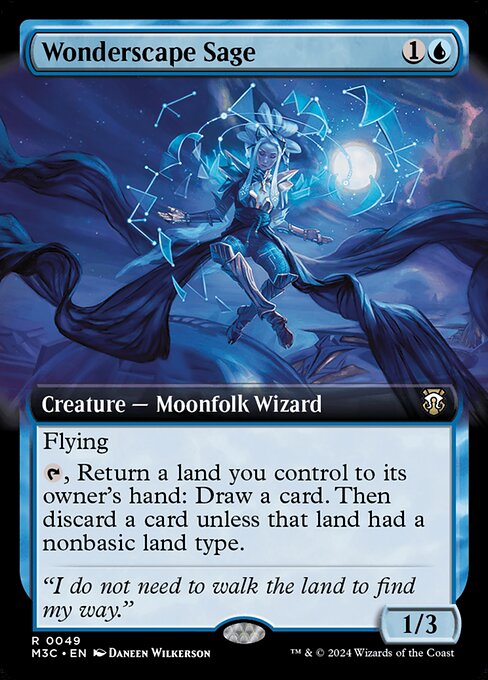
Image courtesy of Scryfall.com
Reading the board: threat assessment for Wonderscape Sage
Blue-lightning tempo meets card advantage in Wonderscape Sage, a rare from Modern Horizons 3 Commander. For players who love the dance of efficiency and information, this Moonfolk Wizard packs a subtle punch that can tilt a game—if you read the room correctly. With a modest 2-mana installation and flying to boot, Sage looks unassuming at first glance, but its activated ability rewards careful land management and decisions that reward patience as the game unfolds 🧙♂️🔥. The flavor text, “I do not need to walk the land to find my way,” nudges you to think about land as a resource you manipulate, not merely produce.
Mechanics in practice
Wonderscape Sage is a 2/2-mana creature with flying, which means it already threatens an evasive line of attack for a few turns. Its real strength, though, lies in its tap ability: {T}, Return a land you control to its owner's hand: Draw a card. Then discard a card unless that land had a nonbasic land type. That is a compact engine in a single activation. You draw a card and often avoid the discard if you bounce a nonbasic land—precisely the kind of conditional advantage blue loves to engineer. If you bounce a basic land, you must discard, which punishes reckless land-wasting plays but rewards smart sequencing with fetchlands, utility lands, and duals that carry nonbasic types 🧠🎲.
From a threat perspective, Sage’s power curve ascends when the table respects the bounce mechanic. In formats where nonbasics proliferate—think dual lands, utility lands, and fetchable shocks—your card draw becomes reliably clean. The elusiveness of a flying body combined with a low mana tax means Sage can pressure life totals while you sculpt your next draw step. The cost of the discard clause is real, especially if your deck leans heavily on basics, but thoughtful deckbuilding can turn that cost into a calculated risk worth taking ⚔️.
Threats and table dynamics
In commander circles, threat assessment often hinges on two axes: board presence and resource efficiency. Wonderscape Sage doesn’t threaten the battlefield with a big body, but its ability to draw into answers or threats accelerates your game plan by one card per activation. In a tempo or control shell, Sage shines when you pair it with lands that help you keep a steady cadence of plays while resisting becoming overburdened by card parity. The flying keyword adds inevitability—your opponent must respect the potential for another draw step, even if you’re not yet presenting a critical mass of damage 🔥.
There’s also a political angle at the table. Sage can force decisions about which lands to bounce and when, influencing opponents to respond or overextend. Because the effect draws one card but may force a discard, the table might perceive Sage as a value engine that risks stalling the game if not paired with acceleration or card draw redundancy. That dynamic blends well with themes of resource denial and tempo denial, two levers blue decks often pull to tilt the match in their favor 🎨.
Deckbuilding notes: when to include Wonderscape Sage
- Land type strategy: Build around nonbasic lands. The discard clause is minimal or non-existent if you bounce lands with nonbasic types, so run fetch-friendly lands, shock lands, or utility lands that carry subtypes beyond basic Plains, Forest, Island, Mountain, or Swamp. The card rewards disciplined land selection more than the typical blue spell swarm. 🧭
- Land ramp and recursion: Include ways to redeploy lands to hand with minimal tempo loss. Recurring fetches or bounce enablers can create a cycle where you draw multiple cards across turns without blowing your resources.
- Card draw redundancy: Sage is a value engine, but it plays best with other sources of card draw. Pair it with wheels, cantrips, or threats that keep your hand stocked while you apply pressure with the Sage-on-board option.
- Protection and resilience: Since Sage is a fragile, low-toughness creature, protection spells or tempo plays that shield it from removal can help you maximize its value before your opponents adapt to your land-bounce plan.
- Flavor and lore alignment: The Moonfolk lineage in blue often leans into cunning resource calculus. Sage fits perfectly into decks that savor land interactions and the rhythm of draw-discard decisions, all while keeping the board light with flying pressure 🪄.
For players who enjoy the cerebral side of MTG—the careful calculus of which land to bounce and when—Wonderscape Sage offers a reliable lens into how small decisions compound. It’s not a slam-dunk game-winner, but it’s the kind of card that rewards thoughtful play over a long marquee match. The synergy with nonbasic lands makes it a natural fit in mana-base-heavy decks, and the flying body ensures you don’t spend the entire game purely on the defense. In a crowded blue metagame, Sage stands out as a steady, sometimes underrated engine that invites both misdirection and respect 🧙♂️💎.
“I do not need to walk the land to find my way.”
That line from the flavor text captures the essence of Wonderscape Sage: it wants you to read the land as a map you manipulate, not a terrain you merely occupy. When you balance tempo with card advantage, that map becomes a route to victory rather than a mere roadmap to fatigue 🎲.
As you test Wonderscape Sage in your builds, balance its tempo with a robust land base and multiple nonbasic options. The card’s strength grows as your table’s land diversity expands, and its potential is unlocked when you lean into resourceful play rather than straightforward brute force. If you’re chasing a blue commander that rewards disciplined land interaction, Sage is a thoughtful companion on the journey 🧙♂️🎨.
Neon Gaming Mouse Pad Rectangular 1/16 in Thick Rubber BaseMore from our network
- https://blog.digital-vault.xyz/blog/post/mtg-wavesifter-market-signals-price-trends-ahead-of-reprint-cycles/
- https://blog.digital-vault.xyz/blog/post/top-commander-pairings-for-cram-sessions-effect/
- https://crypto-acolytes.xyz/blog/post/ai-storytellers-transform-dynamic-rpgs-with-adaptive-narratives/
- https://crypto-acolytes.xyz/blog/post/smart-minecraft-pvp-tips-for-consistent-wins/
- https://blog.digital-vault.xyz/blog/post/stuck-in-summoners-sanctum-mana-curve-simulations-explained/